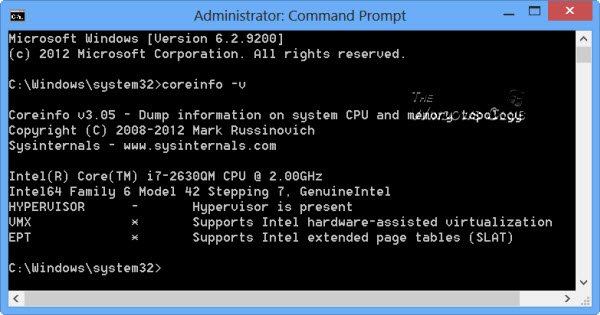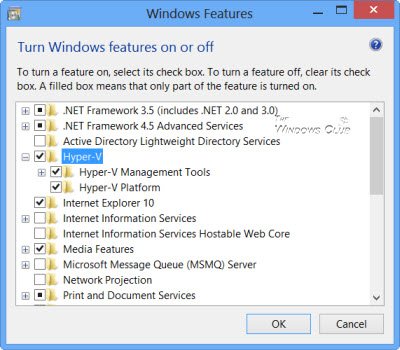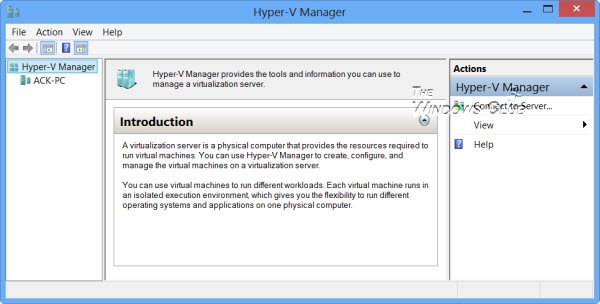Windows 11/10 supports client Hyper-V; a flexible, robust, and high-performance client virtualization technology that enables IT pros and developers to run multiple operating system instances simultaneously on their Windows computer.
Hyper-V requires a 64-bit Windows 11/10/8 system that has at least 4GB RAM and SLAT or Second Level Address Translation. SLAT is a feature of the CPU. It is also called RVI or Rapid Virtualization Indexing. Intel refers to it as EPT or Extended Page Tables and AMD as Nested Page Tables.
Check if your computer supports Hyper-V
SLAT is present in the current generation of 64-bit processors by Intel & AMD; but you may want to re-check if your system supports SLAT. Hyper-V will not install if you don’t meet the requirements.
To do so, download CoreInfo from SysInternals and place it in your System32 folder. Coreinfo is a command-line utility that shows you the mapping between logical processors and the physical processor, NUMA node, and socket on which they reside, as well as the cache’s assigned to each logical processor.
Next, open the Win+X menu by moving your mouse to the bottom left corner and right-clicking. Select Command Prompt (Admin). Type coreinfo -v and hit Enter. The -v command will dump only virtualization-related features including support for second-level address translation.

If you need more information you can visit this link on TechNet.
Read:
- How to enable or disable Hardware virtualization via BIOS
- How to Start & Stop Hyper-V VM using PowerShell
How to enable Hyper-V on Windows 11/10
Power users will find Hyper-V very useful as it provides services and management tools for creating virtual machines and their tools.
To enable Virtualization support, open Control Panel > Programs > Programs and Features > Uninstall a program > Turn Windows features on or off.

Check the option Hyper-V. Hyper-V Management Tools include GUI and command-line tools. The Hyper-V Platform provides services for creating and managing virtual machines and their resources. Click OK.

Windows will search for the required files, apply the changes and finally request you to restart the computer.

When you restart your computer you will be able to see that Hyper-V has been enabled on your Windows 11/10.
Windows Home user? This post will show you how to install and enable Hyper-V on Windows 11 Home.
Now read:
- How to enable TPM in Hyper-V to install Windows 11
- How to disable Hyper-V.
- How to configure and use Hyper-V in Windows 11.
thanks for the article. I’m interested in trying this but i have a few questions. Do the virtual machines run using virtualized drivers? how do games/specialist apps perform if native drivers aren’t present? Is it possible to run a game or an audio package that uses asio drivers etc in each vm?
Hello. For some reason I do not see the Hyper V option in my Windows Features List. I am not running Windows 8 Pro, just the regular version of Windows 8. Would this have something to do with it? Also, I have all of the hardware requirements necessary for Hyper V to work properly. I need Hyper V to run the Windows Phone 8 emulator. Is there a way to download this software another way? I have searched everywhere but haven’t seemed to turn up any useful info, anything would help! Thanks in advance!
You require Windows 8 Pro for Hyper-V.
Anyone else having following problem? Before installing Hyper-V on Windows 8, I run CoreInfo -v, and it reports HYPERVISOR -, EPT *. After installing Hyper-V, CoreInfo -v reports HYPERVISOR *, EPT -.
In the function turn on or off windows features there is no such selection as hyper-v please give some advice
i have Dell Inspiron 5520 model and i want to use an windows phone emmulator. but hyper-v is not enabled in my system what to do??
I am unable to configure my system becoz my bios settings are different and when we add windows features in programs der also hyper-v is not present. plzzz suggest me somthing
can u plzzz tell me that does windows 8.1 supports hyper-v or not??? i m having too much problem i want to use an emulator but hyper-v is not present anywhere in my pc
yes sir i m having probleme of hyper-v in my system is Dell Inspiron 5520 model,in this i cant find Hyper-v anywhere in my system.and in bios virtualization is enabled then tooo its not working plzzzz help mee
I have windows 8.1 Pro. Is there a way to enable Hyper-V Platform without an internet connection? It keeps wanting to Download files from Windows Update.
I’m using windows 8.1 and I can not enable hyper-v , when I try apper the following msg is not possible to enable Hyper-V support for virtualization disabled on firmware….please someone help m
i have hyper-v present according to systeminfo and coreinfo, yet the option for me to enable it in the “turn windows features on or off” is not available, need help with this. urgent work! :/
note: SLAT, VTx and all other requirements are met and thouroghly checked.